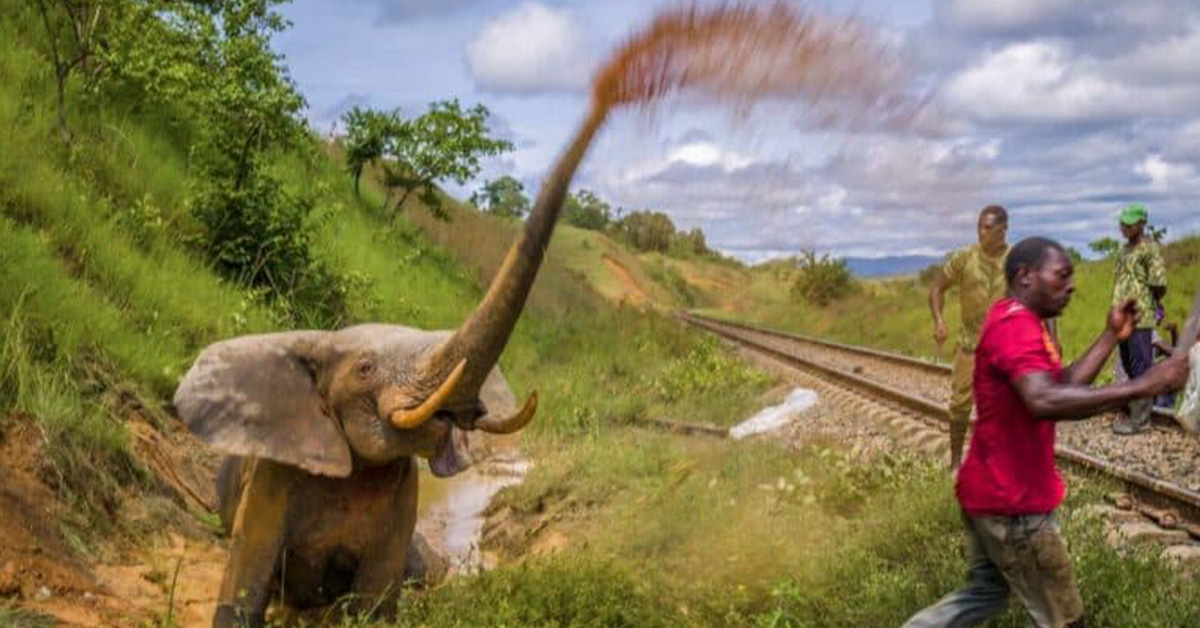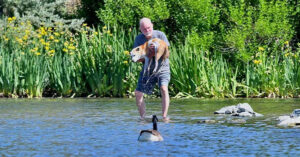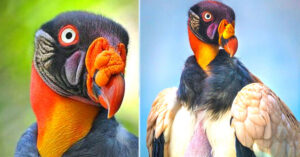Another person tried to cut off the male elephant’s tail after being shot, and the elephant got angry and sprayed water at the people watching. A train carrying manganese between Moanda (in Gabon’s Haut-Ogooué province) and Libreville (the country’s capital) hit the elephant in the middle of the night. The collision broke the elephant’s right hip into several pieces, and eco guards were called to the spot to look into what happened. The park head decided that the elephant had to be killed because it couldn’t be saved. The meat would then be given to the Lopé people. The elephant was shot, but it didn’t die. There was only one bullet left, so the elephant is still fighting for its life. When the shot was fired, the animal got very angry and started spraying water and a railway tie at the people who were watching. The people watching then started to fight back and started throwing rocks at the hurt animal. At the same time, it looks like the community has chosen not to wait for the animal to die but to kill it with machetes instead. It was okay for me to join, but I couldn’t take pictures of the shot or the cutting.
The work of Dutch photographer Jasper Doest is all about “giving a voice to nonhuman lives.” His photographs, which have won awards, tell stories of animals that need our help badly. The GDT European Wildlife Photographer of the Year competition is now giving him an award for his work.
It was Doest’s moving photos of African forest elephants in central Gabon that won him the Fritz Polking Prise for 2023. The award is named for the famous German author and wildlife photographer Fritz Polking, who died in 2007. It is given every year to someone with a great body of work.
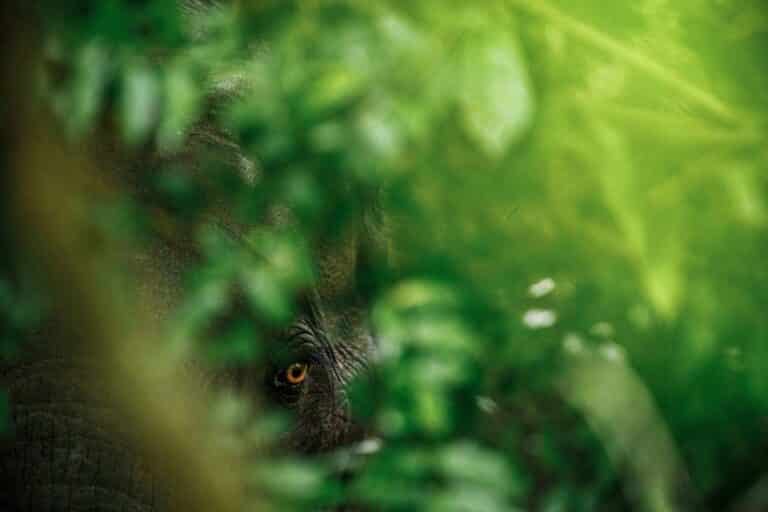
Doest is aware of how all living things on Earth are linked because she majored in ecology. He wants to look into the link between people and nature through his photography. His award-winning series, A Fragile Refuge for Forest Elephants, looks at the jungle of Lopé National Park, which is one of the last safe places in central Gabon for forest elephants. The story for National Geographic took Doest two months to research and write in Gabon.
Doest makes it clear that even these safe places are at risk by showing how climate change is changing the rainforest’s fruit production, which means elephants have less food. He makes it clear in his work that the effects of what people do are everywhere, even in places we can’t even imagine.
In the thick jungles of Lopé National Park, there is an African forest elephant. Because they like to live in dense forests, it’s hard to use traditional methods of counting, like visual identification. However, new study using DNA from dung samples has estimated that there are 95,000 forest elephants in the world, with Gabon being their main home. The other type of elephant in Africa is the African savannah elephant, which is bigger than the African forest elephant. Their tusks are straighter and point downward, and their ears are more oval-shaped. This makes it easier for them to move through thick greenery. African forest elephants eat grasses, leaves, fruits, seeds, and tree bark. They live in groups of up to 20 people. Forest elephants eat mostly fruit, so they are very important for spreading many types of tree seeds, especially the seeds of big trees, which tend to have a lot of carbon in them. Because of this, people call them the “mega-gardener of the forest.”
Also, Doest shows how hard life is in the wildlife reserve, which is crossed by train tracks. Even though these fast trains hurt and kill elephants all the time, it looks like money matters more than what is best for these animals. That’s something Doest will never forget: seeing these accidents and how things were handled afterwards. “I am haunted not only by the tragedy that happened but also by the larger story of human greed that lies beneath it—there is a railway that runs through a National Park, and its main purpose is to move a valuable mineral,” he wrote. “The African Forest Elephant is almost extinct, but for now it is seen here as just another casualty of the mining industry around the world.”
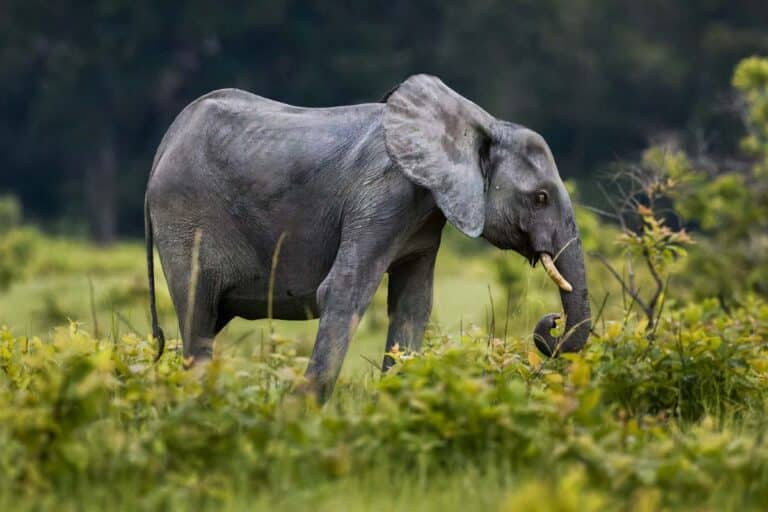
Because Doest’s work brings these tragedies to light, let’s hope that something can be done to help this species that is in danger of going extinct.
The 2023 Fritz Polking Prise went to wildlife photographer Jasper Doest for his moving story about the plight of African forest elephants in central Gabon.

A forest elephant and her young feed on the open savannah on a cloudy day, long before dawn. When you look at the female, it’s clear that she’s not in good health. You can see her individual ribs, the front and back of her pelvic bone being depressed, and her backbone being noticeable from her tail to her head, with deep depressions in the lumbar area. Scientists from the University of Stirling have found that forest elephants at Lopé have been getting less fit over time by looking at more than 2500 shots from 1997 to 2018. Since this information is linked to the forest’s declining fruit production, these drops in both plant reproduction and elephant body health are signs of system-wide change that will likely have a big effect on how the ecosystem works and what it does. As soon as we realised how important this person was to our story, we tried to get closer to her, but she ran off into the bush. After talking to Robin Whytock, I think this elephant would rate its body state as 1-2 on the scale of 1–10 that was used in the study, where 1 was the worst (Robbie: “basically dead”).
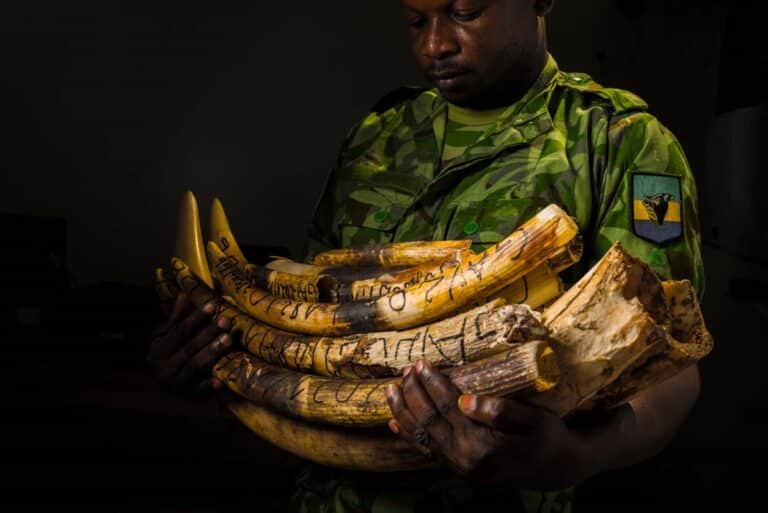
Elephant eating fruits from the Detarium plant. It has to go through an animal’s digestive system before Detarium macrocarpum can sprout. So, the megafauna in the forest are completely responsible for spreading this species’ seeds. In African woodlands, the forest elephant (Loxodonta cyclotis) is the main animal that spreads seeds. Its digestive system lets a lot of seeds pass through without getting killed. NOTE: The elephant ran away after the first shot because the strobes scared it. It never went back to eating in front of the camera while the strobes were on.
Head of Service Landry Babenangoye, who is in charge of fighting hunting in Lutte, holds the tusks of elephants that were killed by trains earlier this year. Twelve elephants were killed by trains in 2021 until December 1, 2021. We will need to check the final number at the end of the year because I’ve been told that more accidents will happen in December because elephants are drawn to the ripe mango trees that grow near the train track. Most of the time, eco-guards were able to keep the ivory safe, since poaching for ivory is the biggest danger to African forest elephants right now. All ivory is recorded in Lopé and then sent to Libreville once it is done. Between 2002 and 2011, the number of forest elephants dropped by 62%. During that time, the species also lost 30% of its range, with Gabon being its last refuge. The African forest elephant was listed as Critically Endangered by the IUCN in 2021 because its numbers are still going down. As the track goes through Lopé National Park and crosses many natural areas, accidents with trains happen there all the time. In fact, four more accidents happened during my last two weeks in Gabon. The park director had his team look at all the possible trouble spots along the track, but the railway company hasn’t done anything with this knowledge yet. Because the trains mostly carry manganese, Gabon’s second-largest export good and making up about 11% of the country’s total exports, the railway company also won’t slow down even though the economy is bad.
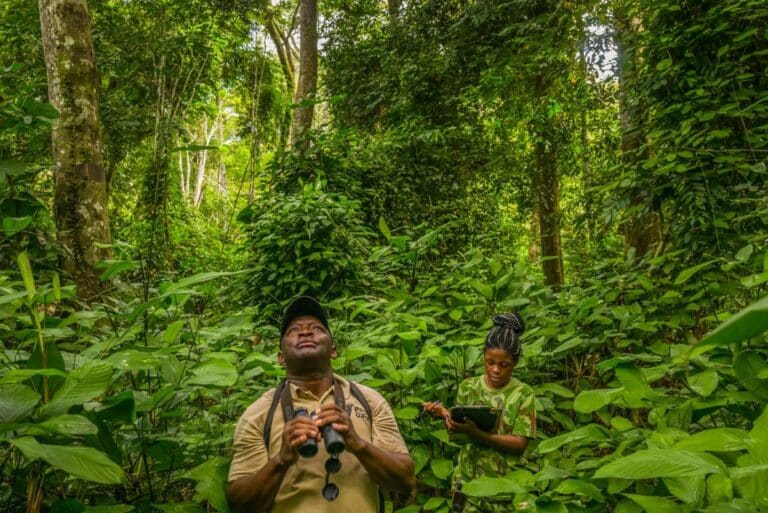
David Dimoto and Lisa-Laure Ndindiwe Malata study the tops of trees in Lopé National Park as part of a monthly phenology study. The longest-running study of tropical tree phenology in Africa has been done in Lopé (G. S. Adamescu et al., 2018). Up until now, experts have been keeping an eye on tree species that gorillas, chimpanzees, and elephants eat from 1986 to the present. With binoculars, focal tree tops are looked at from the ground once a month, and the amounts of each canopy that are covered with flowers, fruit, and leaves are written down. The researchers used these numbers to figure out how likely it was to see flowers, unripe fruit, and ripe fruit for 73 species over 32 years, from 1986 to 2018. They found that trees at Lopé are having fewer babies and that the chances of seeing flowers and fruit have gone down a lot over time. It’s likely that changes in the climate at the spot have caused this change in reproduction. The lowest daily temperature at Lopé has been rising by an average of 0.25°C every ten years because of global warming. This may be a major reason why some tree species aren’t reproducing as well as they used to because they need a certain minimum temperature to flower. At the same time, the site has lost 75 mm of rain every ten years, which means that all tree types may be suffering from a lack of water. Edmond Dimoto, who is 48 years old, was born and raised in the Lopé Department. He has been making these monthly notes since 1996.
